BUS703 Managing Research: Leadership Coaching and Trust Assignment
VerifiedAdded on 2023/06/10
|8
|2051
|260
Homework Assignment
AI Summary
This assignment provides a comprehensive analysis of a research article titled "Leadership coaching, leader role-efficacy, and trust in subordinates." The study, employing a mixed-methods approach, investigates leadership coaching as a leadership development tool. The assignment begins with an evaluation of the literature review, identifying key areas such as leadership coaching, leader role-efficacy, and trust in subordinates. It then examines the characteristics and appropriateness of the mixed-methods research design, assessing its effectiveness in addressing the research objective. The assignment further critiques the data collection methods, including focus group discussions and questionnaires, evaluating their justification and description. Finally, it provides a critique of the research findings, summarizing the study's hypotheses, results, and conclusions regarding the impact of leadership coaching on leader role-efficacy and trust in subordinates. The assignment demonstrates a clear understanding of the research process and the implications of the study's findings.
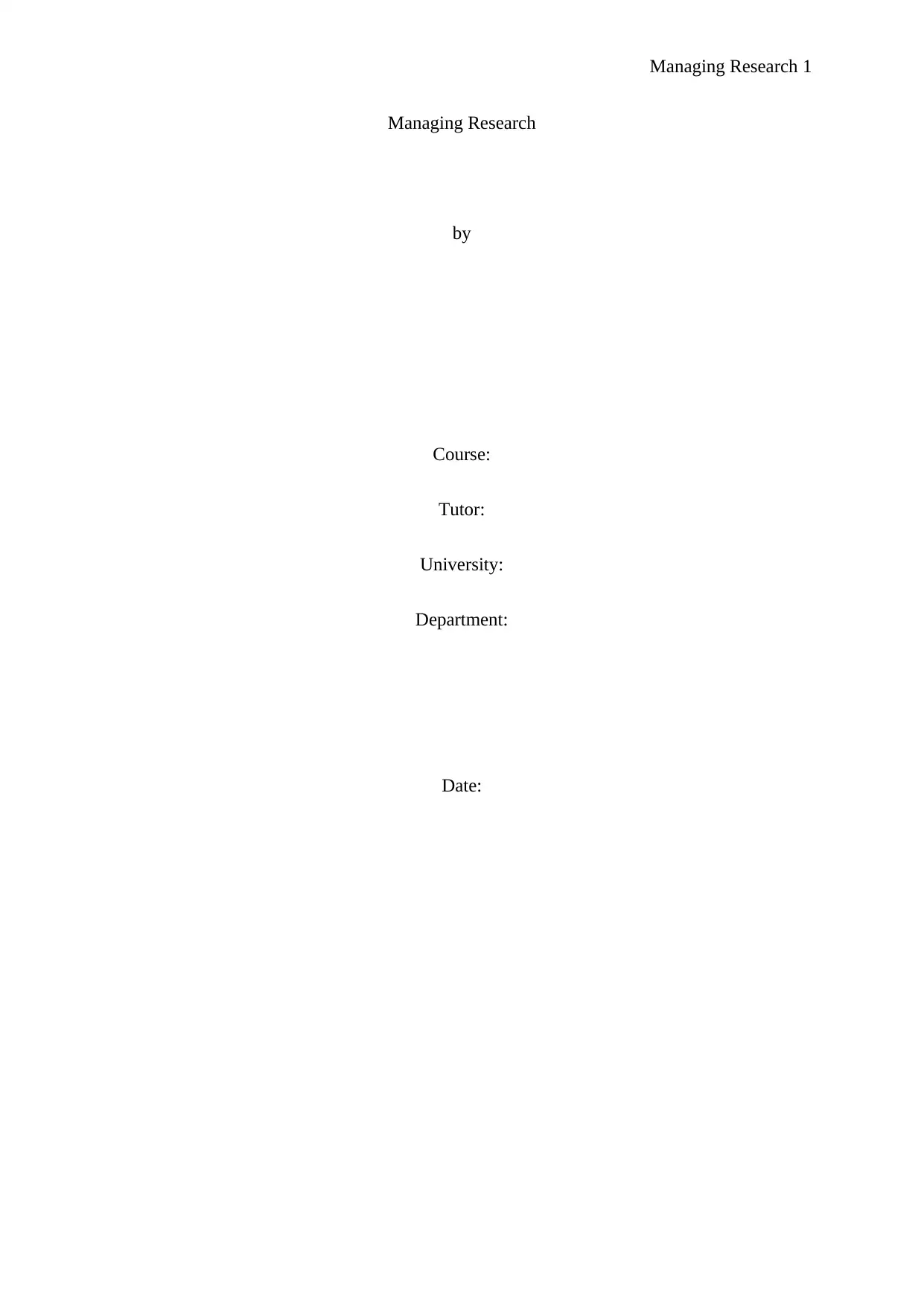
Managing Research 1
Managing Research
by
Course:
Tutor:
University:
Department:
Date:
Managing Research
by
Course:
Tutor:
University:
Department:
Date:
Paraphrase This Document
Need a fresh take? Get an instant paraphrase of this document with our AI Paraphraser
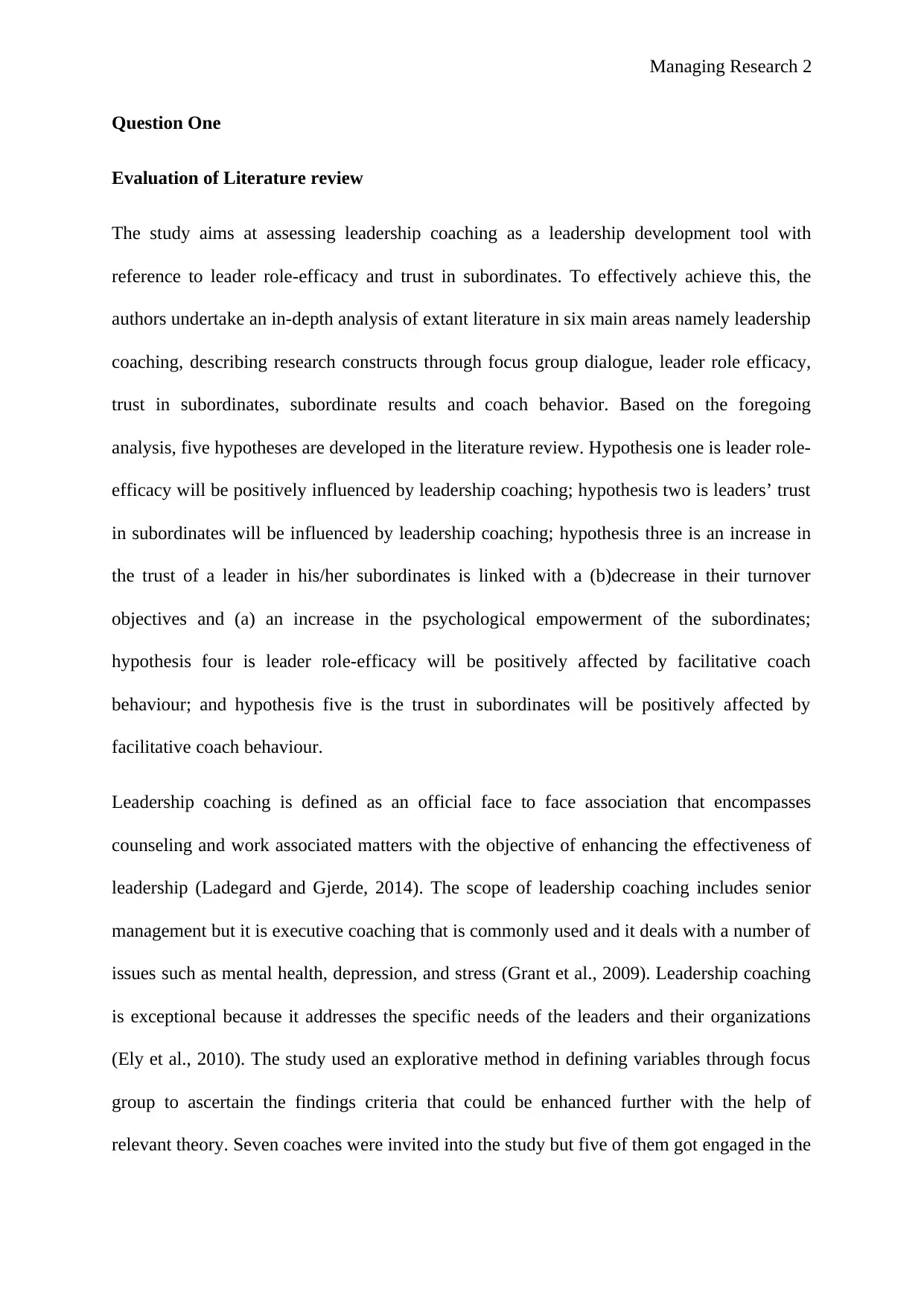
Managing Research 2
Question One
Evaluation of Literature review
The study aims at assessing leadership coaching as a leadership development tool with
reference to leader role-efficacy and trust in subordinates. To effectively achieve this, the
authors undertake an in-depth analysis of extant literature in six main areas namely leadership
coaching, describing research constructs through focus group dialogue, leader role efficacy,
trust in subordinates, subordinate results and coach behavior. Based on the foregoing
analysis, five hypotheses are developed in the literature review. Hypothesis one is leader role-
efficacy will be positively influenced by leadership coaching; hypothesis two is leaders’ trust
in subordinates will be influenced by leadership coaching; hypothesis three is an increase in
the trust of a leader in his/her subordinates is linked with a (b)decrease in their turnover
objectives and (a) an increase in the psychological empowerment of the subordinates;
hypothesis four is leader role-efficacy will be positively affected by facilitative coach
behaviour; and hypothesis five is the trust in subordinates will be positively affected by
facilitative coach behaviour.
Leadership coaching is defined as an official face to face association that encompasses
counseling and work associated matters with the objective of enhancing the effectiveness of
leadership (Ladegard and Gjerde, 2014). The scope of leadership coaching includes senior
management but it is executive coaching that is commonly used and it deals with a number of
issues such as mental health, depression, and stress (Grant et al., 2009). Leadership coaching
is exceptional because it addresses the specific needs of the leaders and their organizations
(Ely et al., 2010). The study used an explorative method in defining variables through focus
group to ascertain the findings criteria that could be enhanced further with the help of
relevant theory. Seven coaches were invited into the study but five of them got engaged in the
Question One
Evaluation of Literature review
The study aims at assessing leadership coaching as a leadership development tool with
reference to leader role-efficacy and trust in subordinates. To effectively achieve this, the
authors undertake an in-depth analysis of extant literature in six main areas namely leadership
coaching, describing research constructs through focus group dialogue, leader role efficacy,
trust in subordinates, subordinate results and coach behavior. Based on the foregoing
analysis, five hypotheses are developed in the literature review. Hypothesis one is leader role-
efficacy will be positively influenced by leadership coaching; hypothesis two is leaders’ trust
in subordinates will be influenced by leadership coaching; hypothesis three is an increase in
the trust of a leader in his/her subordinates is linked with a (b)decrease in their turnover
objectives and (a) an increase in the psychological empowerment of the subordinates;
hypothesis four is leader role-efficacy will be positively affected by facilitative coach
behaviour; and hypothesis five is the trust in subordinates will be positively affected by
facilitative coach behaviour.
Leadership coaching is defined as an official face to face association that encompasses
counseling and work associated matters with the objective of enhancing the effectiveness of
leadership (Ladegard and Gjerde, 2014). The scope of leadership coaching includes senior
management but it is executive coaching that is commonly used and it deals with a number of
issues such as mental health, depression, and stress (Grant et al., 2009). Leadership coaching
is exceptional because it addresses the specific needs of the leaders and their organizations
(Ely et al., 2010). The study used an explorative method in defining variables through focus
group to ascertain the findings criteria that could be enhanced further with the help of
relevant theory. Seven coaches were invited into the study but five of them got engaged in the
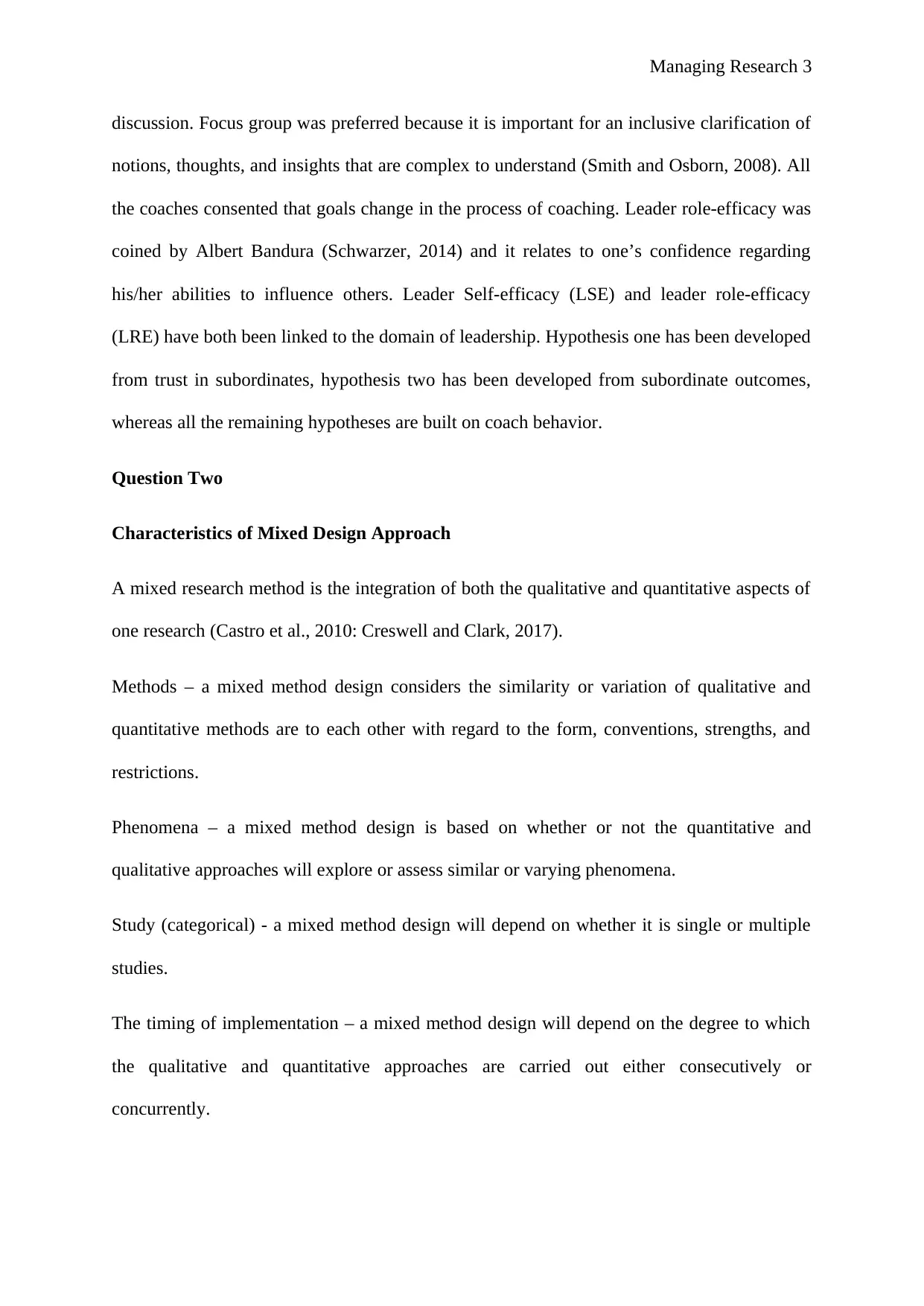
Managing Research 3
discussion. Focus group was preferred because it is important for an inclusive clarification of
notions, thoughts, and insights that are complex to understand (Smith and Osborn, 2008). All
the coaches consented that goals change in the process of coaching. Leader role-efficacy was
coined by Albert Bandura (Schwarzer, 2014) and it relates to one’s confidence regarding
his/her abilities to influence others. Leader Self-efficacy (LSE) and leader role-efficacy
(LRE) have both been linked to the domain of leadership. Hypothesis one has been developed
from trust in subordinates, hypothesis two has been developed from subordinate outcomes,
whereas all the remaining hypotheses are built on coach behavior.
Question Two
Characteristics of Mixed Design Approach
A mixed research method is the integration of both the qualitative and quantitative aspects of
one research (Castro et al., 2010: Creswell and Clark, 2017).
Methods – a mixed method design considers the similarity or variation of qualitative and
quantitative methods are to each other with regard to the form, conventions, strengths, and
restrictions.
Phenomena – a mixed method design is based on whether or not the quantitative and
qualitative approaches will explore or assess similar or varying phenomena.
Study (categorical) - a mixed method design will depend on whether it is single or multiple
studies.
The timing of implementation – a mixed method design will depend on the degree to which
the qualitative and quantitative approaches are carried out either consecutively or
concurrently.
discussion. Focus group was preferred because it is important for an inclusive clarification of
notions, thoughts, and insights that are complex to understand (Smith and Osborn, 2008). All
the coaches consented that goals change in the process of coaching. Leader role-efficacy was
coined by Albert Bandura (Schwarzer, 2014) and it relates to one’s confidence regarding
his/her abilities to influence others. Leader Self-efficacy (LSE) and leader role-efficacy
(LRE) have both been linked to the domain of leadership. Hypothesis one has been developed
from trust in subordinates, hypothesis two has been developed from subordinate outcomes,
whereas all the remaining hypotheses are built on coach behavior.
Question Two
Characteristics of Mixed Design Approach
A mixed research method is the integration of both the qualitative and quantitative aspects of
one research (Castro et al., 2010: Creswell and Clark, 2017).
Methods – a mixed method design considers the similarity or variation of qualitative and
quantitative methods are to each other with regard to the form, conventions, strengths, and
restrictions.
Phenomena – a mixed method design is based on whether or not the quantitative and
qualitative approaches will explore or assess similar or varying phenomena.
Study (categorical) - a mixed method design will depend on whether it is single or multiple
studies.
The timing of implementation – a mixed method design will depend on the degree to which
the qualitative and quantitative approaches are carried out either consecutively or
concurrently.
⊘ This is a preview!⊘
Do you want full access?
Subscribe today to unlock all pages.

Trusted by 1+ million students worldwide
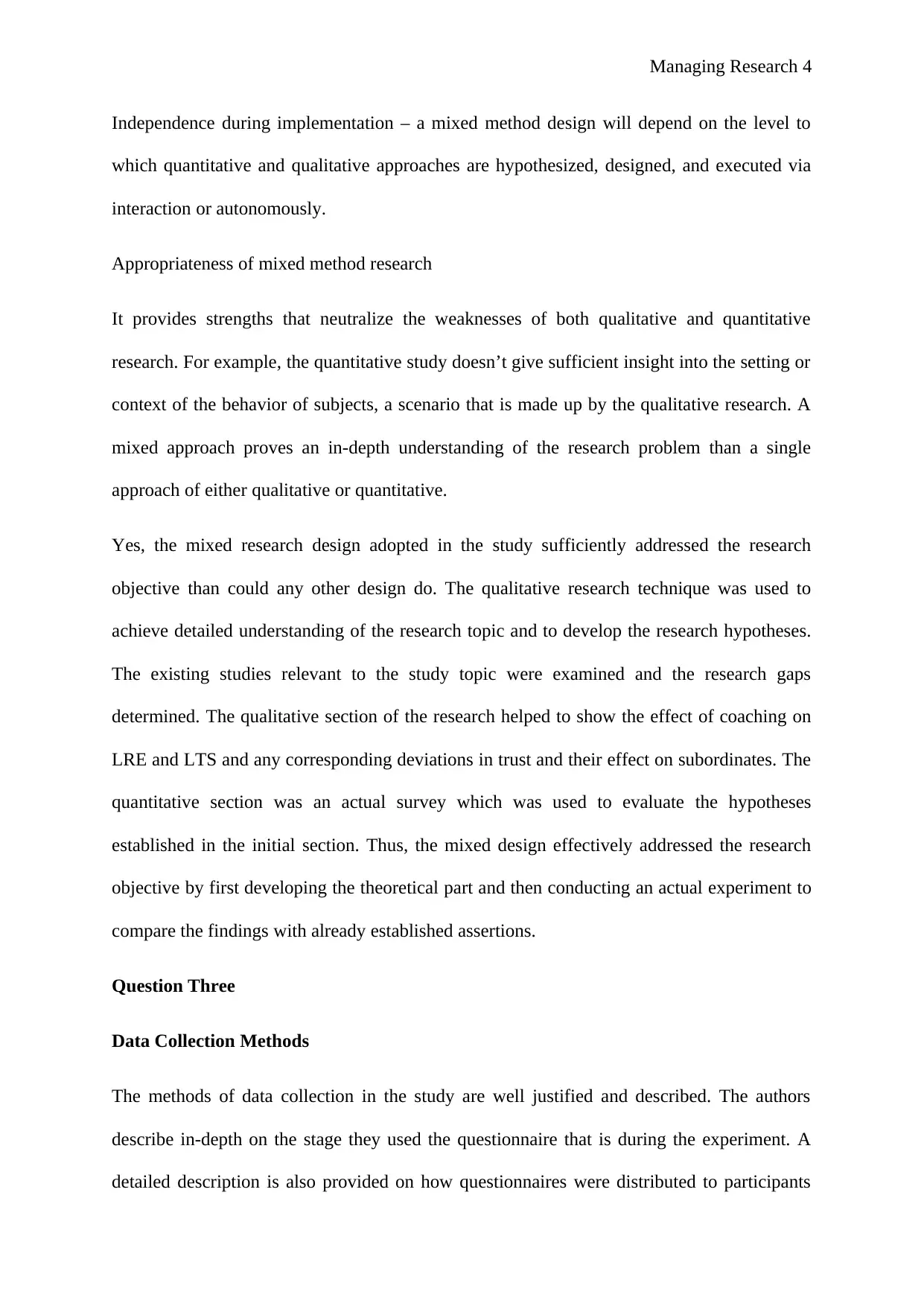
Managing Research 4
Independence during implementation – a mixed method design will depend on the level to
which quantitative and qualitative approaches are hypothesized, designed, and executed via
interaction or autonomously.
Appropriateness of mixed method research
It provides strengths that neutralize the weaknesses of both qualitative and quantitative
research. For example, the quantitative study doesn’t give sufficient insight into the setting or
context of the behavior of subjects, a scenario that is made up by the qualitative research. A
mixed approach proves an in-depth understanding of the research problem than a single
approach of either qualitative or quantitative.
Yes, the mixed research design adopted in the study sufficiently addressed the research
objective than could any other design do. The qualitative research technique was used to
achieve detailed understanding of the research topic and to develop the research hypotheses.
The existing studies relevant to the study topic were examined and the research gaps
determined. The qualitative section of the research helped to show the effect of coaching on
LRE and LTS and any corresponding deviations in trust and their effect on subordinates. The
quantitative section was an actual survey which was used to evaluate the hypotheses
established in the initial section. Thus, the mixed design effectively addressed the research
objective by first developing the theoretical part and then conducting an actual experiment to
compare the findings with already established assertions.
Question Three
Data Collection Methods
The methods of data collection in the study are well justified and described. The authors
describe in-depth on the stage they used the questionnaire that is during the experiment. A
detailed description is also provided on how questionnaires were distributed to participants
Independence during implementation – a mixed method design will depend on the level to
which quantitative and qualitative approaches are hypothesized, designed, and executed via
interaction or autonomously.
Appropriateness of mixed method research
It provides strengths that neutralize the weaknesses of both qualitative and quantitative
research. For example, the quantitative study doesn’t give sufficient insight into the setting or
context of the behavior of subjects, a scenario that is made up by the qualitative research. A
mixed approach proves an in-depth understanding of the research problem than a single
approach of either qualitative or quantitative.
Yes, the mixed research design adopted in the study sufficiently addressed the research
objective than could any other design do. The qualitative research technique was used to
achieve detailed understanding of the research topic and to develop the research hypotheses.
The existing studies relevant to the study topic were examined and the research gaps
determined. The qualitative section of the research helped to show the effect of coaching on
LRE and LTS and any corresponding deviations in trust and their effect on subordinates. The
quantitative section was an actual survey which was used to evaluate the hypotheses
established in the initial section. Thus, the mixed design effectively addressed the research
objective by first developing the theoretical part and then conducting an actual experiment to
compare the findings with already established assertions.
Question Three
Data Collection Methods
The methods of data collection in the study are well justified and described. The authors
describe in-depth on the stage they used the questionnaire that is during the experiment. A
detailed description is also provided on how questionnaires were distributed to participants
Paraphrase This Document
Need a fresh take? Get an instant paraphrase of this document with our AI Paraphraser

Managing Research 5
both in the first and second round and the number of respondents as well. Also, a response
rate of 73% from the collected questionnaires is provided as a justification for continuing
with the experiment and reliability of the findings. The study also carried out a separate
survey for validation of measures of LRE and LTS, out of which questionnaires were
administered. However, the authors have not provided the development of the research
questionnaire with regard to details such as whether the questions were open-ended or close-
ended or both. Also, it is not clear how the questionnaire responses were rated.
The focus group discussions have sufficiently been justified and described. The authors chose
focus group because it is the most effective in an explorative study which involves an area
that is rather new and requires theory development by engaging experiences coaches to
discuss their experiences. Additionally, the authors justify the choice of focus group because
they are important in a detailed exposition of ideas, opinions, and giving insights into
situations that are difficult to acquire through one-on-one interviews. Also, it is an efficient
data collection method in situations where there is a focused topic that can be deliberated
upon. The use of focus group is also described sufficiently by describing how one researcher
acted as a moderator and recorded notes as the deliberations were ongoing, while the other
played the role of an observer and recorded notes as well for comparison afterward during
analysis. The scholars even go further ahead in their description of the data collection method
using a focus group to sample responses from some of the respondents (but with fictitious
names). Therefore, based on the foregoing arguments, it can be concluded that the data
collection methods (focus group and questionnaires) use in the study is sufficiently justified
and described except for the development of the questionnaire and details of the questions in
the questionnaire.
Question Eight
both in the first and second round and the number of respondents as well. Also, a response
rate of 73% from the collected questionnaires is provided as a justification for continuing
with the experiment and reliability of the findings. The study also carried out a separate
survey for validation of measures of LRE and LTS, out of which questionnaires were
administered. However, the authors have not provided the development of the research
questionnaire with regard to details such as whether the questions were open-ended or close-
ended or both. Also, it is not clear how the questionnaire responses were rated.
The focus group discussions have sufficiently been justified and described. The authors chose
focus group because it is the most effective in an explorative study which involves an area
that is rather new and requires theory development by engaging experiences coaches to
discuss their experiences. Additionally, the authors justify the choice of focus group because
they are important in a detailed exposition of ideas, opinions, and giving insights into
situations that are difficult to acquire through one-on-one interviews. Also, it is an efficient
data collection method in situations where there is a focused topic that can be deliberated
upon. The use of focus group is also described sufficiently by describing how one researcher
acted as a moderator and recorded notes as the deliberations were ongoing, while the other
played the role of an observer and recorded notes as well for comparison afterward during
analysis. The scholars even go further ahead in their description of the data collection method
using a focus group to sample responses from some of the respondents (but with fictitious
names). Therefore, based on the foregoing arguments, it can be concluded that the data
collection methods (focus group and questionnaires) use in the study is sufficiently justified
and described except for the development of the questionnaire and details of the questions in
the questionnaire.
Question Eight
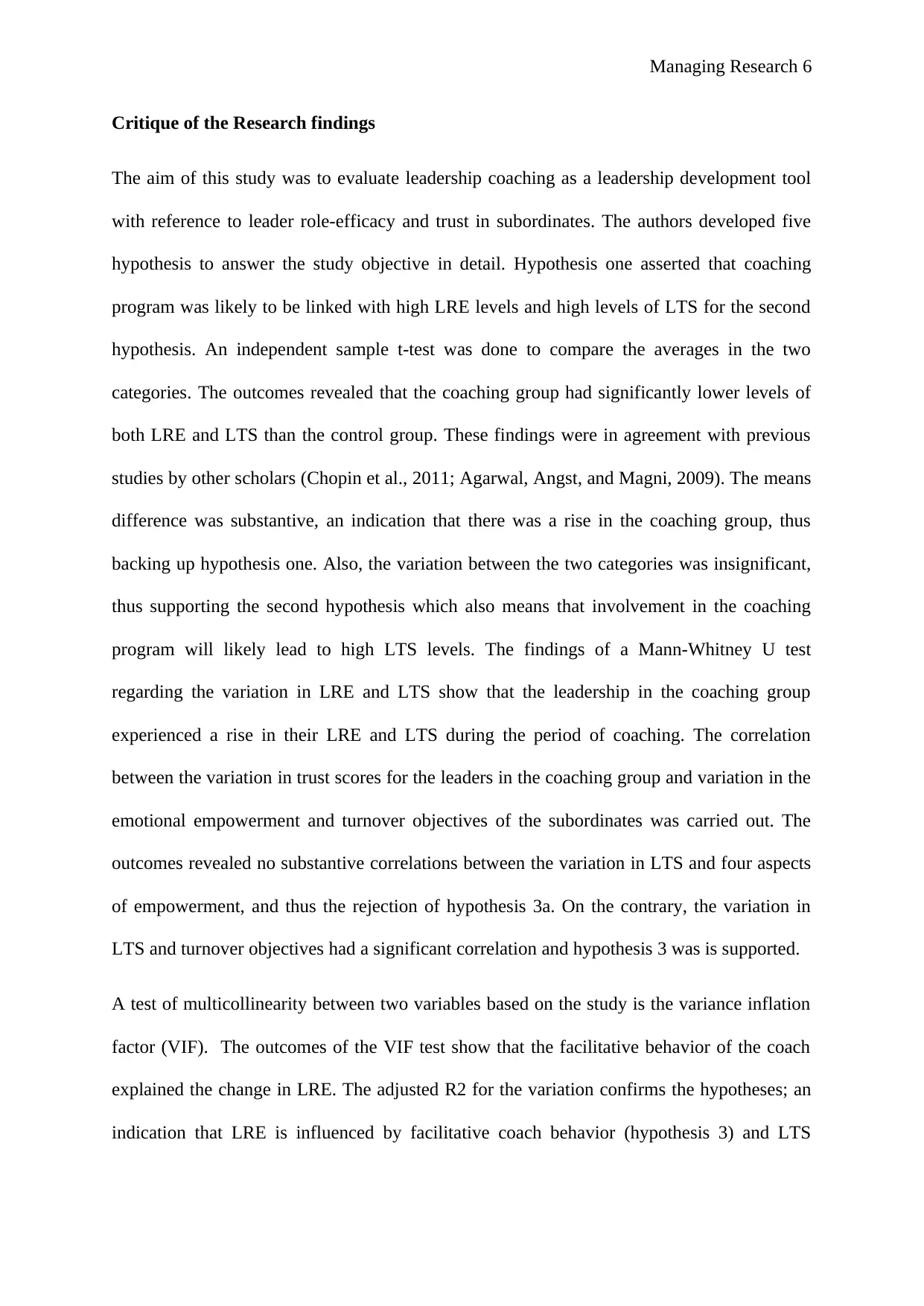
Managing Research 6
Critique of the Research findings
The aim of this study was to evaluate leadership coaching as a leadership development tool
with reference to leader role-efficacy and trust in subordinates. The authors developed five
hypothesis to answer the study objective in detail. Hypothesis one asserted that coaching
program was likely to be linked with high LRE levels and high levels of LTS for the second
hypothesis. An independent sample t-test was done to compare the averages in the two
categories. The outcomes revealed that the coaching group had significantly lower levels of
both LRE and LTS than the control group. These findings were in agreement with previous
studies by other scholars (Chopin et al., 2011; Agarwal, Angst, and Magni, 2009). The means
difference was substantive, an indication that there was a rise in the coaching group, thus
backing up hypothesis one. Also, the variation between the two categories was insignificant,
thus supporting the second hypothesis which also means that involvement in the coaching
program will likely lead to high LTS levels. The findings of a Mann-Whitney U test
regarding the variation in LRE and LTS show that the leadership in the coaching group
experienced a rise in their LRE and LTS during the period of coaching. The correlation
between the variation in trust scores for the leaders in the coaching group and variation in the
emotional empowerment and turnover objectives of the subordinates was carried out. The
outcomes revealed no substantive correlations between the variation in LTS and four aspects
of empowerment, and thus the rejection of hypothesis 3a. On the contrary, the variation in
LTS and turnover objectives had a significant correlation and hypothesis 3 was is supported.
A test of multicollinearity between two variables based on the study is the variance inflation
factor (VIF). The outcomes of the VIF test show that the facilitative behavior of the coach
explained the change in LRE. The adjusted R2 for the variation confirms the hypotheses; an
indication that LRE is influenced by facilitative coach behavior (hypothesis 3) and LTS
Critique of the Research findings
The aim of this study was to evaluate leadership coaching as a leadership development tool
with reference to leader role-efficacy and trust in subordinates. The authors developed five
hypothesis to answer the study objective in detail. Hypothesis one asserted that coaching
program was likely to be linked with high LRE levels and high levels of LTS for the second
hypothesis. An independent sample t-test was done to compare the averages in the two
categories. The outcomes revealed that the coaching group had significantly lower levels of
both LRE and LTS than the control group. These findings were in agreement with previous
studies by other scholars (Chopin et al., 2011; Agarwal, Angst, and Magni, 2009). The means
difference was substantive, an indication that there was a rise in the coaching group, thus
backing up hypothesis one. Also, the variation between the two categories was insignificant,
thus supporting the second hypothesis which also means that involvement in the coaching
program will likely lead to high LTS levels. The findings of a Mann-Whitney U test
regarding the variation in LRE and LTS show that the leadership in the coaching group
experienced a rise in their LRE and LTS during the period of coaching. The correlation
between the variation in trust scores for the leaders in the coaching group and variation in the
emotional empowerment and turnover objectives of the subordinates was carried out. The
outcomes revealed no substantive correlations between the variation in LTS and four aspects
of empowerment, and thus the rejection of hypothesis 3a. On the contrary, the variation in
LTS and turnover objectives had a significant correlation and hypothesis 3 was is supported.
A test of multicollinearity between two variables based on the study is the variance inflation
factor (VIF). The outcomes of the VIF test show that the facilitative behavior of the coach
explained the change in LRE. The adjusted R2 for the variation confirms the hypotheses; an
indication that LRE is influenced by facilitative coach behavior (hypothesis 3) and LTS
⊘ This is a preview!⊘
Do you want full access?
Subscribe today to unlock all pages.

Trusted by 1+ million students worldwide

Managing Research 7
(hypothesis4). This further confirms hypotheses one and two that the rise in LRE and LTS
will be facilitated by leadership coaching.
Therefore, the objective of testing whether leadership coaching could affect the hypothesized
outcome criteria with regard to high LRE and LTS have been confirmed in the findings and
thus the objective stated initially is achieved.
References
Agarwal, R., Angst, C.M. and Magni, M., 2009. The performance effects of coaching: A
multilevel analysis using hierarchical linear modeling. The International Journal of Human
Resource Management, 20(10), pp.2110-2134.
Castro, F.G., Kellison, J.G., Boyd, S.J. and Kopak, A., 2010. A methodology for conducting
integrative mixed methods research and data analyses. Journal of mixed methods
research, 4(4), pp.342-360.
Chopin, S.M., Danish, S.J., Seers, A. and Hook, J.N., 2012. Effects of mentoring on the
development of leadership self‐efficacy and political skill. Journal of Leadership
Studies, 6(3), pp.17-32.
Creswell, J.W. and Clark, V.L.P., 2017. Designing and conducting mixed methods research.
Sage publications.
Ely, K., Boyce, L.A., Nelson, J.K., Zaccaro, S.J., Hernez-Broome, G. and Whyman, W.,
2010. Evaluating leadership coaching: A review and integrated framework. The leadership
quarterly, 21(4), pp.585-599.
Grant, A.M., Curtayne, L. and Burton, G., 2009. Executive coaching enhances goal
attainment, resilience and workplace well-being: A randomised controlled study. The Journal
of Positive Psychology, 4(5), pp.396-407.
(hypothesis4). This further confirms hypotheses one and two that the rise in LRE and LTS
will be facilitated by leadership coaching.
Therefore, the objective of testing whether leadership coaching could affect the hypothesized
outcome criteria with regard to high LRE and LTS have been confirmed in the findings and
thus the objective stated initially is achieved.
References
Agarwal, R., Angst, C.M. and Magni, M., 2009. The performance effects of coaching: A
multilevel analysis using hierarchical linear modeling. The International Journal of Human
Resource Management, 20(10), pp.2110-2134.
Castro, F.G., Kellison, J.G., Boyd, S.J. and Kopak, A., 2010. A methodology for conducting
integrative mixed methods research and data analyses. Journal of mixed methods
research, 4(4), pp.342-360.
Chopin, S.M., Danish, S.J., Seers, A. and Hook, J.N., 2012. Effects of mentoring on the
development of leadership self‐efficacy and political skill. Journal of Leadership
Studies, 6(3), pp.17-32.
Creswell, J.W. and Clark, V.L.P., 2017. Designing and conducting mixed methods research.
Sage publications.
Ely, K., Boyce, L.A., Nelson, J.K., Zaccaro, S.J., Hernez-Broome, G. and Whyman, W.,
2010. Evaluating leadership coaching: A review and integrated framework. The leadership
quarterly, 21(4), pp.585-599.
Grant, A.M., Curtayne, L. and Burton, G., 2009. Executive coaching enhances goal
attainment, resilience and workplace well-being: A randomised controlled study. The Journal
of Positive Psychology, 4(5), pp.396-407.
Paraphrase This Document
Need a fresh take? Get an instant paraphrase of this document with our AI Paraphraser

Managing Research 8
Ladegard, G. and Gjerde, S., 2014. Leadership coaching, leader role-efficacy, and trust in
subordinates. A mixed methods study assessing leadership coaching as a leadership
development tool. The Leadership Quarterly, 25(4), pp.631-646.
Schwarzer, R. ed., 2014. Self-efficacy: Thought control of action. Taylor & Francis.
Smith, J.A. and Osborn, M., 2008. Interpretative phenomenological analysis. JA Smith (Ed.),
Qualitative psychology: A practical guide to research methods (51–80).
Ladegard, G. and Gjerde, S., 2014. Leadership coaching, leader role-efficacy, and trust in
subordinates. A mixed methods study assessing leadership coaching as a leadership
development tool. The Leadership Quarterly, 25(4), pp.631-646.
Schwarzer, R. ed., 2014. Self-efficacy: Thought control of action. Taylor & Francis.
Smith, J.A. and Osborn, M., 2008. Interpretative phenomenological analysis. JA Smith (Ed.),
Qualitative psychology: A practical guide to research methods (51–80).
1 out of 8
Related Documents
Your All-in-One AI-Powered Toolkit for Academic Success.
+13062052269
info@desklib.com
Available 24*7 on WhatsApp / Email
![[object Object]](/_next/static/media/star-bottom.7253800d.svg)
Unlock your academic potential
Copyright © 2020–2025 A2Z Services. All Rights Reserved. Developed and managed by ZUCOL.





